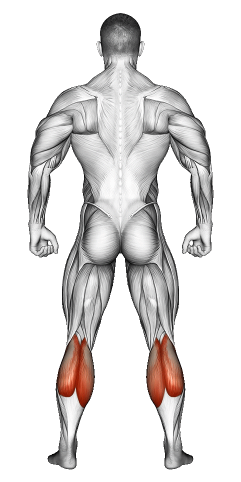Seated Barbell Calf Raise: Video Tutorial & Exercise Guide

Written By: Claude Michael
Updated: Oct 13, 2024
| Workout | Seated Barbell Calf Raise |
| Primary Muscle Group | Calves |
| Equipment Required | Barbell, Bench |
| Force Type | Push |
| Mechanics | Isolation |
| Exercise Type | Strength |
| Difficulty | Beginner |
Seated Barbell Calf Raise: Video Tutorial & Exercise Guide
- 1.Seated Barbell Calf Raise: Muscle Groups
- -1.1Primary Muscle Group
- -1.2Secondary Muscle Group
- 2.Seated Barbell Calf Raise: Step-by-Step Guide
- 3.Seated Barbell Calf Raise: Overview
- 4.Seated Barbell Calf Raise: Benefits
- 5.Seated Barbell Calf Raise: Pro Tips & Advanced Techniques
- 6.Seated Barbell Calf Raise: Progression Plan
- 7.Seated Barbell Calf Raise: Frequently Asked Questions (FAQs)
Seated Barbell Calf Raise: Step-by-Step Guide
- Step 1: Sit on a flat bench with your feet flat on the floor, positioned shoulder-width apart, and place a barbell across your thighs, just above your knees. Hold the barbell securely with both hands.
- Step 2: Place your toes and the balls of your feet on a raised platform, such as a small block or weight plate, with your heels hanging off the edge.
- Step 3: Press through the balls of your feet to lift your heels as high as possible, focusing on contracting your calf muscles.
- Step 4: Pause at the top of the movement to squeeze your calves, then slowly lower your heels back down, allowing them to dip below the platform for a full stretch.
- Step 5: Repeat for the desired number of reps, maintaining a slow and controlled motion throughout.
Seated Barbell Calf Raise: Overview
The Seated Barbell Calf Raise is an isolation exercise targeting the soleus muscle in the calf. Unlike standing calf raises, which emphasize the gastrocnemius, the seated version focuses on the deeper soleus muscle, which helps provide stability and size to the lower leg. This exercise is performed while sitting, with added weight placed across the thighs using a barbell.
Seated Barbell Calf Raises are effective for building muscle and strength in the calves, particularly in the lower portion. They are suitable for intermediate to advanced lifters but can be modified for beginners by using lighter weights.
Seated Barbell Calf Raises: Benefits
Seated Barbell Calf Raises primarily target the soleus muscle, helping to build a well-rounded calf appearance. Strengthening the soleus can improve lower leg stability, which is essential for activities such as running, walking, and jumping.
This exercise is particularly useful for those looking to build calf size, as the seated position allows for better isolation of the soleus muscle. The use of a barbell adds significant resistance, making it easier to progressively overload the calves and encourage muscle growth.
Seated Barbell Calf Raise: Pro Tips & Advanced Techniques
For maximum effectiveness, ensure you’re using a full range of motion—lower your heels below the platform for a deep stretch and raise them as high as possible for a strong contraction. Focus on slow, controlled movements to avoid bouncing, which reduces tension on the calves. For an extra challenge, perform the exercise with one leg at a time or increase the time spent at the top of each rep to maximize the muscle contraction.
Seated Barbell Calf Raises: Progression Plan
Beginner
Intermediate
Advanced
Seated Barbell Calf Raise: Frequently Asked Questions (FAQs)
What muscles do Seated Barbell Calf Raises target?
+Seated Barbell Calf Raises primarily target the soleus muscle in the calves. This muscle is responsible for stability and plays a crucial role in lower leg strength.
Is the Seated Barbell Calf Raise suitable for beginners?
+Yes, beginners can perform this exercise with lighter weights. Focus on mastering the form and using a full range of motion before increasing the load.
How often should I perform Seated Barbell Calf Raises?
+Include this exercise in your leg workout routine 1-2 times per week. Allow for adequate recovery time between sessions to avoid overtraining your calves.
What common mistakes should I avoid?
+Avoid bouncing or rushing through the movement. Focus on slow, controlled reps and ensure you fully extend and contract your calves during each repetition.
Can I perform this exercise with other equipment?
+Yes, you can perform Seated Calf Raises using a Smith machine or specialized calf raise machines if a barbell isn’t available. The key is maintaining proper form and control during the exercise.
Share
Don’t Wish for It, Work for It – Join the FlexXP Newsletter Today!
Thank you for signing up for the FlexXP Newsletter!
This site is protected and the Google Privacy Policy and Terms of Service apply.
